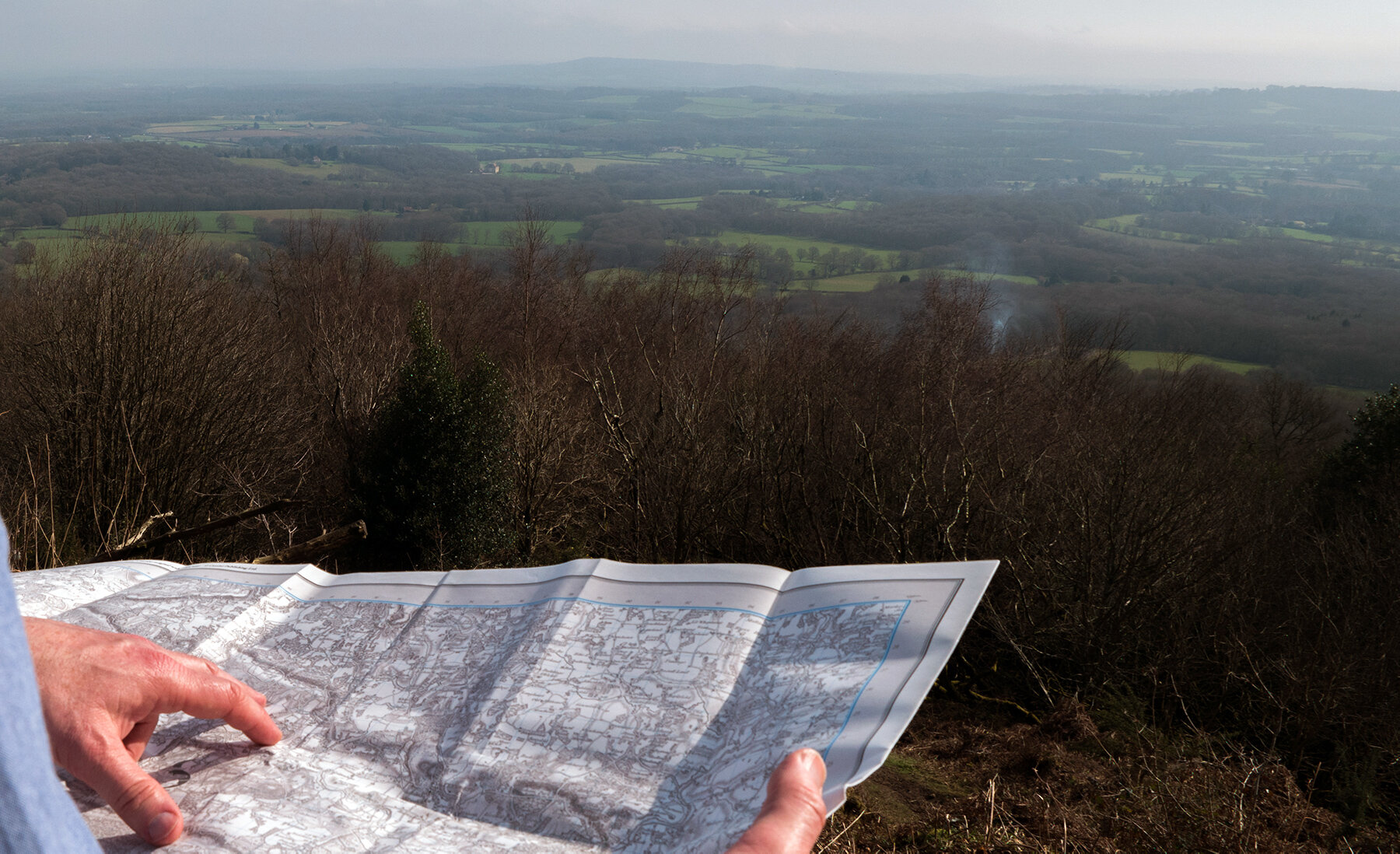
Wayfaring Navigation
Buying from the pictured links helps sustain my website without costing you anything extra. Thank you!
Britain’s footpaths are simple to navigate, but you will (almost) certainly need a map.
I started my Wayfaring with dreams of mapless freedom, but this choice soon led me to cul-de-sacs and motorways. Until one day a kind stranger flung me an OS map, which gave me the Eagle’s view of the land ahead, and helped me make wiser route choices.
The classic UK map option is Ordnance Survey paper maps. These are lovely to hold, and show you a wide view of the landscape, with world-leading data even at consumer level. You can see a far wider context of landscape than any screen allows, which is important for route-planning.
Maps on the 1:50,000 scale (Landranger - the pink maps) are good enough, but get 1:25,000 scale (Explorer - the orange maps) if you can. The larger scale is simply clearer and easier to follow. Plus, it shows springs and wells. For longer distances, this may not be practical, and you may end up with an expensive map habit. I have got across a whole 1:25k map in a day before, and you still have to carry them afterward…
There are other map-makers in the UK. Harveys maps are the best alternative to OS, and offers a range of route specific maps that may be more convenient, in 1:40k scale. But nothing beats OS for clarity and ease of use.
Some Wayfarers like to navigate by the stars and the lay of the land. A book like Tristan Gooley’s ‘The Natural Navigator’ will be hugely helpful in getting started down this path of knowledge.
Don’t forget a compass to ensure your following of the map is not upside down.
Basic Compass - 60g - £10
Digital Maps
Most Wayfarers carry a device with an advanced GPS chip inside it - the smartphone in your pocket. With this device, you store all the OS maps you need for far less money, and zero extra weight. Plus, with the press of a button they show EXACTLY WHERE YOU ARE. It is Harry-Potterish magic. This is the sole reason I bought a smartphone. This works for iPhone, Android and all other platforms.
You need an app. There are many competing apps. Make sure you get one which does not require data or wifi connection - offline map storage is crucial, or you will be reliant on mobile phone coverage, which is not reliable, and you’ll be without access to maps you’ve paid for. Be sure to download all relevant sections onto your smartphone before setting out. Most apps do this automatically.
OS Maps offer their own app. It gets mixed reviews. An advantage is its subscription model, which means no large upfront cost. You can have offline access to all the UK OS mapping - in 1:25k and 1:50k - for £3 per month. If you are Wayfaring for less than a month, this may be all you need to spend! Otherwise, you can subscribe for a whole year for £24. I find this app rather awkward to use.
UK Maps is a very solid option for Wayfarers, with a lot of flexibility and features not offered anywhere else. With the best terrain shading possible, UK Map combines OS Opendata with OSM footpaths, and allows GPX files to be saved in-app. It has an incredible 3D function, and OS maps can also be purchased and stored for offline use.
Memory Map is my personal favorite. This is a little tricky at the front end, but once you are set up, Memory Map is the easiest app to quickly consult on the path, with the simplest user experience. And it doesn’t drain your phone battery. The downside is you can only subscribe annually You can subscribe to OS maps in 1:25k for a year for £30, or in 1:50k for £20. OR you can pay £40 for both levels of detail. You can share access to these maps over 5 devices, which means you can plan at home with Memory Map software, and split the cost with other Wayfaring pals.
A great advantage of digital over paper OS maps is that the cost of updating maps is built-in. You won’t end up with a stack of maps lacking the latest motorways or housing estates. Most subscription model map apps also allow you to print out maps as often as you like, to support your journey.
The disadvantage of smartphone GPS mapping is that you are reliant on a delicate and vulnerable device. If you are Wayfaring in a group, make sure more than one of you has access to digital maps and the route. Spreading the risk over multiple devices is a simple way to mitigate potential danger. A dropped phone can be a dead phone, and in adverse weather, phones can be slippery blighters. Also, in cold weather you need special gloves to consult them, and the screens can be hard to see. But a paper map is not much better in such conditions.
Also, a phone is only good while its battery lasts. For this reason, always carry a charge external battery. These ones from Anker are pretty solid choices. Don’t forget the cable!
Anker Powercore - 20,000 mAh - 350g - £24
Dedicated GPS Device
As well as smartphone GPS, you can get OS maps loaded onto a dedicated GPS device. These have the advantage of being tougher, more rugged, and with dedicated functionality they will survive worse weather and more drops. Also, batteries tend to last many days, a vast improvement over a Smartphone.
The best UK GPS devices are the Satmap Activs. These are professional standard devices, and extremely useful if you are living off a map for long periods. That being said, I bought and carried one for a while, and it remained an unused emergency device, which cost an awful lot and weighs a whole lump (500g). So after two seasons of carrying it without using it, I now leave this at home (edit - I recently sold it).
However, if you are a solo Wayfarer and want to be safe at all costs, consider looking into these devices. They are a little more awkward to use than the slick systems of a smartphone, but may offer the security you require. Though it might be cheaper to carry a second smartphone?
Other handheld GPS devices by brands like Garmin do not offer OS mapping, so are pretty much useless on the hills of Britain.
Route Planning Before You Go
I discuss this on the Routes page. It’s worth plotting a route. But also, good to be willing to deviate.
Adaptation on the Path
You may set off with a strict plan of where to go and how to get there, but do not imagine this will remain fixed. The path has other ideas, and you would do well to be flexible. Strangers offering suggestions are usually to be considered. Sub-quests to rare flowers, strange caves or legendary waterfalls should always be accepted. A Wayfaring journey has an intelligence of its own, and you should surrender to it as much as you can.
Also follow your own nose and instincts. If you notice another path that did not stand out on the maps, or if the way ahead feels not quite right, listen to your innate intelligence and adapt your way. It is rare you will regret doing so. Navigation is not an imposition of your will on the path, but a harmonic response to the changing conditions (internal and external) that you encounter.
If you meet impasse, and cannot decide which way to turn, trust your staff. It will help send you on the right path. You can use the spinning method (flung rotating in the air like a helicopter) or the upright method (balanced and allowed to fall). If the staff’s suggestion seems entirely inappropriate, this too is an answer.
The Joy of Trespass
There has been much recent talk of trespass and the ‘right to roam’. In Scotland, you can walk freely almost anywhere (within reason). This causes almost no problems, and everyone cracks on happily. But in England and Wales, land is more jealously guarded, which gives rise to less respect and thus causes more problems.
The story of Britain’s journey toward access of the countryside is not a smooth and accommodating tale. Resistance by landowners has been longstanding and jagged. To learn about trespass in Britain, read Nick Hayes’ excellent recent book.
In the most common-sense and basic way imaginable, we are all animals on the Earth and land ownership is an illusion conjured from ancient violence. In more evolved human futures, such myths shall dissolve. But we live here now, and so must deal with how things are.
If you see somewhere you really feel called to walk to, do so with rightesousness. But go gently and respectfully, and be ready to apologise if challenged. The best counter to people accusing you of trespass is extreme polite friendliness. This is powerful kung-fu, Jesus style. But even better is to remain subtle and quiet enough to evade any such challenge. As such, it is always good advice to avoid wearing garish and bright colours while Wayfaring. Red berghaus jackets will make you visible from miles away.
At the end of the day, the punishment for roaming harmlessly on someone else’s land is to be asked to retrace your steps and leave. And that is no terrible thing. If you do encounter trouble, be sure to film it with your camera for safety.
The key to trespass is respect. Do not leave gates open, do not spook livestock, and do not damage anything. If your presence is the only problem caused, you can easily remedy this issue, and you may find that many old school farmers have no problem with you at all.
Navigate your way with joy and strength, and walk well!








